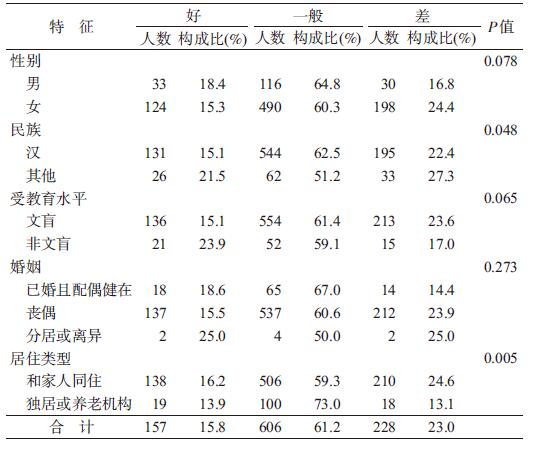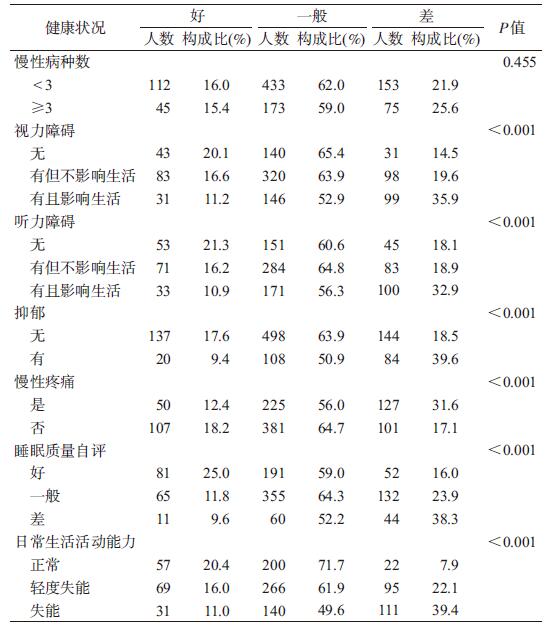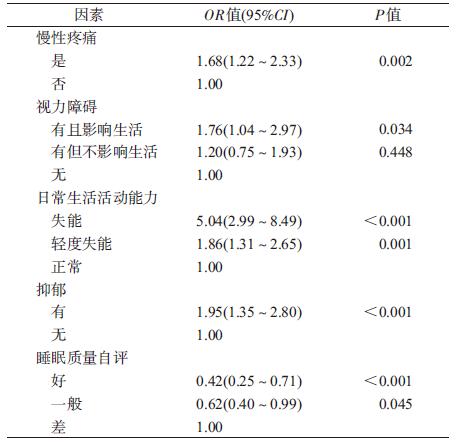文章信息
- 姚尧, 刘淼, 杨姗姗, 王建华, 朱乔, 陈小萍, 甯超学, 李靖, 张福, 栾复新, 赵亚力, 何耀.
- Yao Yao, Liu Miao, Yang Shanshan, Wang Jianhua, Zhu Qiao, Chen Xiaoping, Ning Chaoxue, Li Jing, Zhang Fu, Luan Fuxin, Zhao Yali, He Yao.
- 海南省百岁老人健康自评状况及其影响因素研究
- Study on self-rated health and related factors in centenarians in Hainan province
- 中华流行病学杂志, 2018, 39(3): 264-267
- Chinese Journal of Epidemiology, 2018, 39(3): 264-267
- http://dx.doi.org/10.3760/cma.j.issn.0254-6450.2018.03.003
-
文章历史
收稿日期: 2017-10-09
2. 100853 北京, 中国人民解放军总医院老年医学研究所 肾脏疾病国家重点实验室;
3. 572000 三亚, 中国人民解放军总医院海南分院中心实验室
2. State Key Laboratory of Kidney Disease, Chinese People's Liberation Army General Hospital, Beijing 100853, China;
3. Central Laboratory, Hainan Branch of Chinese People's Liberation Army General Hospital, 572000 Sanya, China
我国已进入老年化社会,而老年高龄化又是其中突出表现之一。健康自评(self-rated health/self-perceived health)是个体对自身健康状况的主观评价和估计[1]。有研究表明,该指标与老年人群日常生活活动能力(ADL)、认知功能、衰弱相关,同时对于不良健康结局和死亡风险具有良好预测作用[2-4],已广泛用于老年人群健康评估。本研究对海南省百岁老人健康自评状况及影响因素进行调查,为提高该人群健康水平和生活质量提供基础数据。
对象与方法1.研究对象:2014年6月至2016年12月根据海南省老龄委提供的全省18个市(县)百岁老人分布名单进行全样本横断面调查,除去部分死亡、无法联系、搬迁、住院等失访和拒绝参与本研究的对象,共计991例百岁老人纳入研究,具体研究设计及抽样方法见参考文献[5]。本研究通过解放军总医院伦理委员会审查,研究对象签署知情同意书。
2.研究方法:采取入户上门法采集百岁老人基本资料,包括问卷访谈、体格检查和实验室血液样本检测,由经过系统培训的本地口音护士完成问卷访谈、人体指标(身高、体重、血压)测量。问卷部分包括健康自评、一般人口学特征(年龄、性别、文化程度、民族、婚姻状况、居住情况)、主要慢性疾病(高血压、心脏病、糖尿病、血脂异常、呼吸系统疾病、骨关节系统疾病、恶性肿瘤)、听力及视力情况、慢性疼痛、睡眠质量、ADL等;实验室检测包括FPG、TC、TG、HDL-C、LDL-C。
3.指标定义:健康自评采用五分类法,分别为很好、好、一般、差和很差[6],分析中发现百岁老人健康自评为很好(1例,0.1%)和很差(24例,2.4%)人数较少,故分别合并至好和差组中。高血压采用《中国高血压防治指南》2010版标准[7];糖尿病采用《我国2型糖尿病防治指南》2013版进行糖尿病诊断[8];血脂异常诊断按《中国成人血脂异常防治指南》2016年修订版[9];根据老年抑郁综合征量表(GDS-15)评估抑郁状况,得分≥7被认为处于抑郁状态[10];慢性疼痛定义为老人身体某部位有持续1个月以上的疼痛[11];主要慢性病结合体检结果、疾病自报及慢性病用药史进行判断;视力、听力情况分为没问题、有但不影响生活和有且影响生活三类;根据老人主观自评睡眠质量,分为好、一般、差;ADL采用Barthel量表(共有10个条目)评估,每个条目根据不同失能情况评0、5、10或15分,满分100分,评分标准:ADL≥95分为功能正常,60~90分为轻度活动能力损失,<60分为失能[12]。
4.统计学分析:采用SPSS 17.0(SPSS Inc.,Chicago,IL)软件,计量资料以x±s描述,采取独立样本t检验进行比较分析;计数资料采用例数和百分比表示,采取χ2检验进行比较分析;采取多因素logistic回归分析影响健康自评相关因素的OR值及其95%CI。
结果1.样本特征:991例百岁老人年龄(102.85±2.7)岁。女性(812例,81.9%)、汉族(870例,87.8%)、文盲(903例,91.1%)、丧偶(886例,89.4%)、同家人居住(854例,86.2%)占多数;其中健康自评为好的157例(15.8%),一般606例(61.2%),差228例(23.0%)。男性、非文盲、已婚的百岁老人健康自评为好的高于女性、文盲、丧偶者,但差异无统计学意义;非汉族、与家人同住者健康自评为好的高于汉族、独居者,差异有统计学意义(P<0.05)。见表 1。
2.不同健康状况老人健康自评比较:293例患≥3种慢性疾病老人的健康自评与患<3种慢性疾病者比较,差异无统计学意义(P=0.455)。无听力及视力障碍、抑郁、慢性疼痛者健康自评分别优于有上述问题者(P<0.01)。睡眠质量自评为好、ADL正常者其健康自评为好的比例高于异常者,差异有统计学意义(P<0.01)。见表 2。
3.健康自评相关影响因素:以百岁老人健康自评为因变量(好或一般=0,差=1),单因素分析中差异有统计学意义的变量为自变量,进行多因素logistic回归分析。结果显示慢性疼痛、视力障碍、ADL失能、抑郁、睡眠质量自评是影响健康自评的主要影响因素,其中有慢性疼痛、视力障碍、ADL失能、抑郁是良好健康自评的危险因素,而良好睡眠自评为保护因素(P<0.05)。见表 3。
目前国内尚无百岁老人自评健康相关研究报道。本文结果显示,991例海南省百岁老人中15.8%自评健康为好,23.0%自评健康为差;其自评健康主要影响因素为慢性疼痛、视力障碍、抑郁、睡眠情况和ADL。其中健康自评为好和差的百岁老人,均低于希腊的研究报道(分别为37%和33%[13])。尽管海南省百岁老人女性中健康自评为好者低于男性,但性别间差异无统计学意义,并与希腊和美国的研究结果类似[13-14]。与家人同住百岁老人健康自评为好者的比例显著高于独居或养老机构者,差异有统计学意义,说明家人陪伴与照顾对老年人的主观健康评价的正向影响较大。
本研究将百岁老人根据慢性病种数分组比较发现,患慢性病≥3种者健康自评为差者略高于患慢性病<3种者(26% : 21%),但差异无统计学意义,在多因素分析中该结果与单因素研究一致,说明该人群中患慢性疾病可能对主观健康评价的影响作用并不明显,本文结果与丹麦相关研究相似[15]。多因素logistic回归分析发现,影响百岁老人健康自评的因素主要为慢性疼痛、视力障碍、抑郁、睡眠质量自评和ADL;其中慢性疼痛、视力障碍、抑郁及失能是健康自评的危险因素;而自评睡眠质量较好是百岁老人健康自评的保护因素。较好的视力可以帮助老人更好的适应周边环境,与家人和邻居进行正常沟通交流,有利于其身心健康;慢性疼痛可导致睡眠质量障碍和生活满意度下降,同时睡眠质量不佳可导致老年人身心健康水平下降,从而慢性疼痛和睡眠质量障碍与主观健康自评较差有关[16-17];ADL正常的老年人生活基本能够自理,较轻度依赖和失能者心理健康水平更高,抑郁发生率更低,从而主观健康评分更高[18]。
本研究为横断面设计,不能确定百岁老人健康自评与其主要影响因素之间的因果关系,尚需通过前瞻性研究进一步验证相关假说。
综上所述,海南省百岁老人健康自评为好者的比例低于西方国家相关研究结果,健康自评的主要影响因素为慢性疼痛、视力障碍、抑郁、睡眠质量和ADL。提示应针对影响该人群健康自评的相关因素进行综合干预,以提高其生活质量和减轻不良健康自评相关的疾病风险及社会经济负担。
利益冲突: 无
| [1] | Mossey JM, Shapiro E. Self-rated health:a predictor of mortality among the elderly[J]. Am J Public Health, 1982, 72(8): 800–808. DOI:10.2105/AJPH.72.8.800 |
| [2] | Kaori K, Richard Z, Schechter CB, et al. Personality, self-rated health, and cognition in centenarians:Do personality and self-rated health relate to cognitive function in advanced age?[J]. Aging, 2013, 5(3): 183. DOI:10.18632/aging.100545 |
| [3] | Ghorbani SR, Nagyova I, Klein D, et al. Self-rated health mediates the association between functional status and health-related quality of life in Parkinson's disease[J]. J Clin Nurs, 2014, 23(13/14): 1970–1977. DOI:10.1111/jocn.12442 |
| [4] |
方向华, 孟琛, 刘向红, 等. 健康自评与老年人健康状况的前瞻性研究[J]. 中华流行病学杂志, 2003, 24(3): 184–188.
Fang XH, Meng C, Liu XH, et al. Study on the relationship between self-rated health situation and health status in the elderly-an 8-year follow-up study from Multidimentional Longitudinal Study of Aging in Beijing[J]. Chin J Epidemiol, 2003, 24(3): 184–188. DOI:10.3760/j.issn:0254-6450.2003.03.006 |
| [5] |
何耀, 栾复新, 姚尧, 等. 中国海南百岁老人队列研究:研究设计及初步结果[J]. 中华流行病学杂志, 2017, 38(9): 1292–1298.
He Y, Luan FX, Yao Y, et al. China Hainan centenarian cohort study:study design and preliminary results[J]. Chin J Epidemiol, 2017, 38(9): 1292–1298. DOI:10.3760/cma.j.issn.0254-6450.2017.09.029 |
| [6] | Jylhä M, Guralnik JM, Ferrucci L, et al. Is self-rated health comparable across cultures and genders?[J]. J Gerontol B Psychol Sci Soc Sci, 1998, 53(3): S144–152. DOI:10.1093/geronb/53B.3.S144 |
| [7] |
中国高血压防治指南修订委员会. 中国高血压防治指南2010[J]. 中华心血管病杂志, 2011, 39(7): 579–616.
Writing Group of 2010 Chinese Guidelines for the Management of Hypertension. 2010 Chinese guidelines for the management of hypertension[J]. Chin J Cardiol, 2011, 39(7): 579–616. DOI:10.3760/cma.j.issn.0253-3758.2011.07.002 |
| [8] |
中华医学会糖尿病学分会. 中国2型糖尿病防治指南(2013年版)[J]. 中华糖尿病杂志, 2014(7): 447–498.
Chinese Diabetes Society, Chinese Medical Association. 2013 Chinese guidelines for the management of type 2 diabetes[J]. Chin J Diabetes, 2014(7): 447–498. DOI:10.3760/cma.j.issn.1674-5809.2014.07.004 |
| [9] |
中国成人血脂异常防治指南修订联合委员会. 中国成人血脂异常防治指南(2016年修订版)[J]. 中华心血管病杂志, 2016, 44(10): 833–853.
Joint Committee for Developing Chinese Guidelines on Prevention and Treatment of Dyslipidemia in Adults. Chinese guidelines on prevention and treatment of dyslipidemia in adults (2016)[J]. Chin J Cardiol, 2016, 44(10): 833–853. DOI:10.3760/cma.j.issn.0253-3758.2016.10.005 |
| [10] | Conradsson M, Rosendahl E, Littbrand H, et al. Usefulness of the geriatric depression scale 15-item version among very old people with and without cognitive impairment[J]. Aging Mental Health, 2013, 17(5): 638–645. DOI:10.1080/13607863.2012.758231 |
| [11] | Merskey H. Classification of chronic pain:Descriptions of chronic pain syndromes and definitions of pain terms[J]. Pain, 1995, 3(2): 226. DOI:10.1097/00002508-199506000-00024 |
| [12] |
樊瑾, 于普林, 李小鹰, 等. 中国健康老年人标准(2013)解读2——健康评估方法[J]. 中华老年医学杂志, 2014, 33(1): 1–3.
Fan J, Yu PL, Li XY, et al. Recognition of standard on Chinese healthy elderly(2013)-health measurement scales[J]. Chin J Geriat, 2014, 33(1): 1–3. DOI:10.3760/cma.j.issn.0254-9026.2014.01.001 |
| [13] | Tigani X, Artemiadis AK, Alexopoulos EC, et al. Self-rated health in centenarians:a nation-wide cross-sectional Greek study[J]. Arch Gerontol Geriatr, 2012, 54(3): e342–348. DOI:10.1016/j.archger.2012.01.012 |
| [14] | Crimmins EM, Kim JK, Solé-Auró A. Gender differences in health:results from SHARE, ELSA and HRS[J]. Eur J Public Health, 2011, 21(1): 81–91. DOI:10.1093/eurpub/ckq022 |
| [15] | Andersen-Ranberg K, Schroll M, Jeune B. Healthy centenarians do not exist, but autonomous centenarians do:a population-based study of morbidity among Danish centenarians[J]. J Am Geriatr Soc, 2001, 49(7): 900–908. DOI:10.1046/j.1532-5415.2001.49180.x |
| [16] | Chen Q, Hayman LL, Shmerling RH, et al. Characteristics of chronic pain associated with sleep difficulty in older adults:the Maintenance of Balance, Independent Living, Intellect, and Zest in the Elderly (MOBILIZE) Boston Study[J]. J Am Geriatr Soc, 2011, 59(8): 1385–1392. DOI:10.1111/j.1532-5415.2011.03544.x |
| [17] |
李杰, 董青, 刘娟娟, 等. 安徽省农村老年人睡眠与生活质量现况调查[J]. 中华流行病学杂志, 2010, 31(4): 405–408.
Li J, Dong Q, Liu JJ, et al. Sleep and quality of life among rural elderly in Anhui province[J]. Chin J Epidemiol, 2010, 31(4): 405–408. DOI:10.3760/cma.j.issn.0254-6450.2010.04.010 |
| [18] |
罗雅楠, 王振杰, 郑晓瑛. 中老年人日常活动能力变化与抑郁症状关系的研究[J]. 中华流行病学杂志, 2017, 38(8): 1055–1059.
Luo YN, Wang ZJ, Zheng XY. Association between the change of daily living activities and symptoms of depression in Chinese middle-aged and elderly people[J]. Chin J Epidemiol, 2017, 38(8): 1055–1059. DOI:10.3760/cma.j.issn.0254-6450.2017.08.011 |
 2018, Vol. 39
2018, Vol. 39





